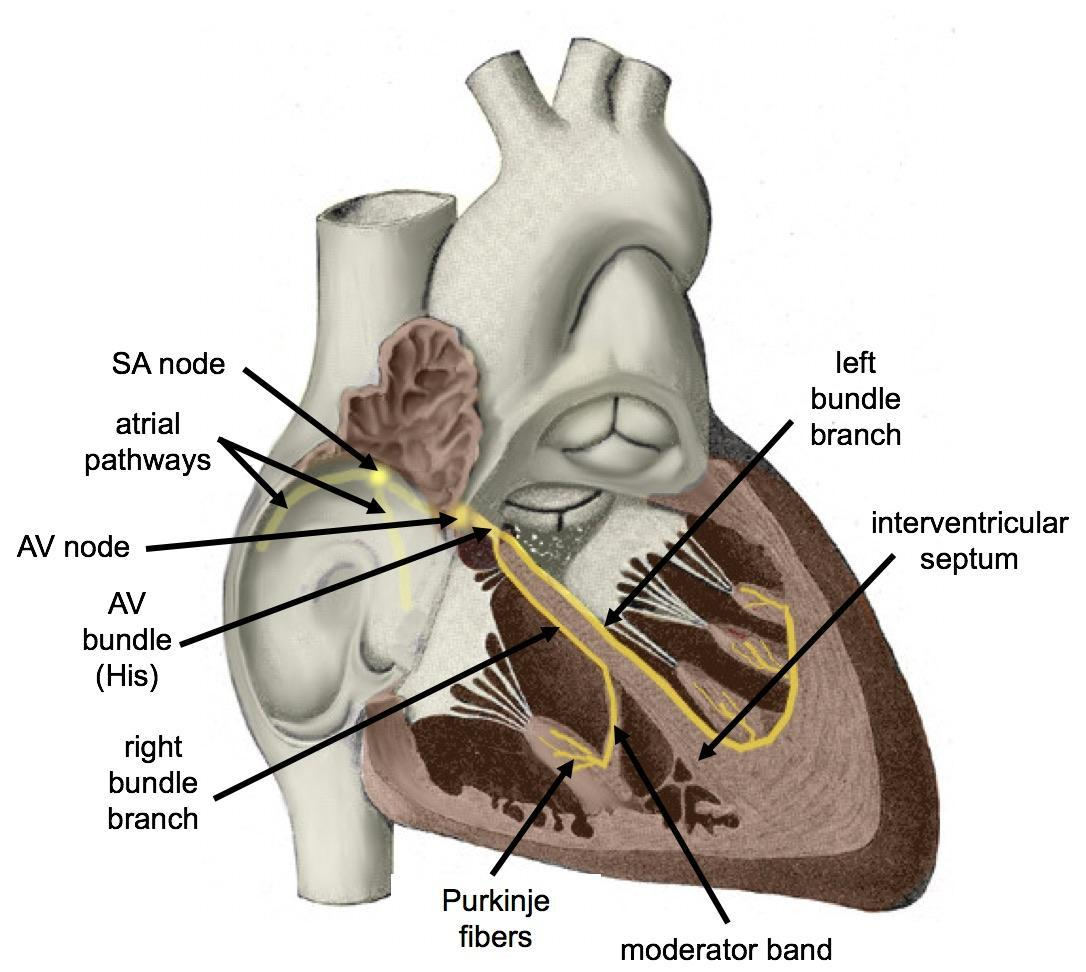
The heartbeat is initiated by nodal tissue made of specialized cardiac muscles called
A. Spongy tissue
B. Purkinje tissue
C. Alveolar tissue
D. None of these
Answer
470.1k+ views
Hint: The most powerful fiber network present in the ventricles helps in initiating the heartbeat. These fibers are rich in mitochondria, have sodium gates and less myofibrils. These fibers help in conducting the signals from Bundle of HIS and helps in completing one whole heartbeat. The cells are electrically excitable cells. The cells are more efficient than any other cell present inside the heart. They are found in the sub-endocardium layer of the heart.
Complete answer:
Nodal tissues are those types of cardiac muscular fibers which help in sending electrical signals from SA nodes (sino-atrial nodes) to the conduction system of the heart.
Conduction system of the heart consists of SAN, AVN, Bundle of His, Bundle branches and Purkinje tissues.
Purkinje Tissues are very powerful nodal tissues as they are rich in mitochondria, have sodium channels and amount of myofibrils are quite less comparative to the other cells present in the heart.
The heartbeat is initiated by the SAN which sends the electrical signal to the AVN. This signal when reached to AVN, results in contraction of atrium (left and right).
AVN further passes the signal to Bundle of His and this electrical signal travels from bundle of His to bundle branches (present at the septum) and then the signal passes to Purkinje Tissues.
When Purkinje tissues receive this signal (at the ventricles), the left and right ventricles contract. This contraction can be monitored in an ECG Machine (QRS complex).
This contraction results in pumping of the blood out of the heart.
After the blood goes out of the heart, the muscles of ventricles relax and the ECG machine shows a nearly straight line depicting that the muscles have now relaxed.
When SAN sends the electrical signal again, this results in contraction of the atrium and completion of a heartbeat.
So, the correct answer is “Option b”.

Note:
Electrical signal travels through the heart by two types of cells- conducting cells and muscle fibers. Conducting cells are responsible for activating muscle fibers which further helps in contraction and relaxation of the atrium and ventricle. Purkinje tissue is located under the sub-endocardium layer and they are the most efficient fibers present in the heart. They help in conducting the signal faster than other cells hence they play an important role in maintaining the heartbeat. Also, when SAN fails to conduct the electrical signal, Purkinje fibers can also initiate the electric signal but the rate is much less compared to the SAN (SAN maintains a \[60 - 100\] beats per minute whereas Purkinje fibers maintain \[10 - 40\]beats per minute), although this work is reserved for adverse conditions and usually SAN carries out the work.
Complete answer:
Nodal tissues are those types of cardiac muscular fibers which help in sending electrical signals from SA nodes (sino-atrial nodes) to the conduction system of the heart.
Conduction system of the heart consists of SAN, AVN, Bundle of His, Bundle branches and Purkinje tissues.
Purkinje Tissues are very powerful nodal tissues as they are rich in mitochondria, have sodium channels and amount of myofibrils are quite less comparative to the other cells present in the heart.
The heartbeat is initiated by the SAN which sends the electrical signal to the AVN. This signal when reached to AVN, results in contraction of atrium (left and right).
AVN further passes the signal to Bundle of His and this electrical signal travels from bundle of His to bundle branches (present at the septum) and then the signal passes to Purkinje Tissues.
When Purkinje tissues receive this signal (at the ventricles), the left and right ventricles contract. This contraction can be monitored in an ECG Machine (QRS complex).
This contraction results in pumping of the blood out of the heart.
After the blood goes out of the heart, the muscles of ventricles relax and the ECG machine shows a nearly straight line depicting that the muscles have now relaxed.
When SAN sends the electrical signal again, this results in contraction of the atrium and completion of a heartbeat.
So, the correct answer is “Option b”.

Note:
Electrical signal travels through the heart by two types of cells- conducting cells and muscle fibers. Conducting cells are responsible for activating muscle fibers which further helps in contraction and relaxation of the atrium and ventricle. Purkinje tissue is located under the sub-endocardium layer and they are the most efficient fibers present in the heart. They help in conducting the signal faster than other cells hence they play an important role in maintaining the heartbeat. Also, when SAN fails to conduct the electrical signal, Purkinje fibers can also initiate the electric signal but the rate is much less compared to the SAN (SAN maintains a \[60 - 100\] beats per minute whereas Purkinje fibers maintain \[10 - 40\]beats per minute), although this work is reserved for adverse conditions and usually SAN carries out the work.
Recently Updated Pages
Master Class 11 Economics: Engaging Questions & Answers for Success

Master Class 11 Business Studies: Engaging Questions & Answers for Success

Master Class 11 Accountancy: Engaging Questions & Answers for Success

Master Class 11 English: Engaging Questions & Answers for Success

Master Class 11 Computer Science: Engaging Questions & Answers for Success

Master Class 11 Maths: Engaging Questions & Answers for Success

Trending doubts
Why was the Vernacular Press Act passed by British class 11 social science CBSE

Name the nuclear plant located in Uttar Pradesh class 11 social science CBSE

What steps did the French revolutionaries take to create class 11 social science CBSE

One Metric ton is equal to kg A 10000 B 1000 C 100 class 11 physics CBSE

How did silk routes link the world Explain with three class 11 social science CBSE

Difference Between Prokaryotic Cells and Eukaryotic Cells




